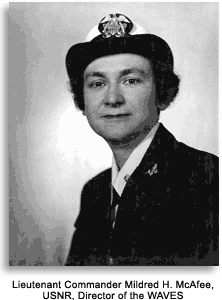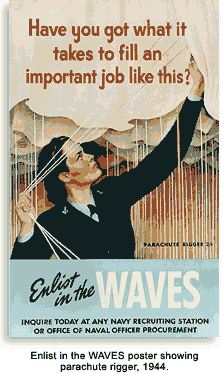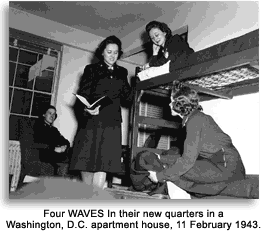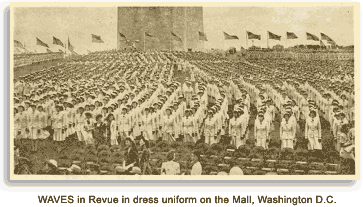Throughout World War II women contributed to the war effort in various fields of endeavor. Women Accepted for Volunteer Emergency Service (WAVES), a unit of the U.S. Naval Reserve, was one such field. Their numerous contributions proved to be a vital asset to winning the war as well as proving that mixed-gender forces could be successful.
 A nudge from Eleanor Roosevelt prompted the navy to consider a women’s reserve corps. Congress was slow to recognize the need for women in the navy, but President Roosevelt realized that servicewomen would be a wartime plus, and signed the corps into law on July 30, 1942. Mildred McAfee, president of Wellesley College, was sworn in as a naval reserve lieutenant commander, the first female commissioned officer of the U.S. Navy and the first director of the WAVES.
By early August 1942 a great number of women from every state applied for the general navy service positions offered in Bainbridge, Maryland. The intensive 12-week training course entailed eight-hour days of classroom study. The women, equivalent to yeomen, were trained to perform secretarial and clerical functions. The first class consisted of 644 women, and subsequent classes produced a maximum of 1,250 graduates. The results exceeded expectations; by fall 1942, the U.S. Navy had produced a record 10,000 women for active service.
Later serving in a wide range of occupations, the WAVES performed jobs in the aviation community, medical professions, science, technology and communications. The navy established the WAVES to perform the same assignments as the WACs with such duties as control tower operations. For that position the preferred candidate had to meet the following criteria, to be and to have:
A nudge from Eleanor Roosevelt prompted the navy to consider a women’s reserve corps. Congress was slow to recognize the need for women in the navy, but President Roosevelt realized that servicewomen would be a wartime plus, and signed the corps into law on July 30, 1942. Mildred McAfee, president of Wellesley College, was sworn in as a naval reserve lieutenant commander, the first female commissioned officer of the U.S. Navy and the first director of the WAVES.
By early August 1942 a great number of women from every state applied for the general navy service positions offered in Bainbridge, Maryland. The intensive 12-week training course entailed eight-hour days of classroom study. The women, equivalent to yeomen, were trained to perform secretarial and clerical functions. The first class consisted of 644 women, and subsequent classes produced a maximum of 1,250 graduates. The results exceeded expectations; by fall 1942, the U.S. Navy had produced a record 10,000 women for active service.
Later serving in a wide range of occupations, the WAVES performed jobs in the aviation community, medical professions, science, technology and communications. The navy established the WAVES to perform the same assignments as the WACs with such duties as control tower operations. For that position the preferred candidate had to meet the following criteria, to be and to have:
 The WAVES' assignments remained stateside, or in Alaska and Hawaii. Publicity depicted their numerous contributions, which indirectly made combat victories possible. Their diverse images, portrayed on posters, in magazines, and on billboards were not only morale boosters, but also encouraged other women to enlist. The navy did come under fire for excluding African-American women from the ranks.*
A final attraction to join the WAVES became reality when the Navy awarded women equal pay and rank in October 1943. WAVES were now subject to the same regulations and requirements for promotions as men. That created a huge incentive for women to enlist and, within a year, 27,000 women wore the WAVES uniform.
The U.S. Navy regulated all aspects of the WAVES' physical appearance. In 1944, Josephine Forrestal, wife of the Assistant Secretary of the Navy, asked noted fashion designer Main Rousseau Bocher to create a stylish uniform. He then donated his designs to the navy for the WAVES. Each enlistee was given four uniforms: summer greys, summer dress whites, working blues, and of course, dress blues. Navy regulations specified that WAVES should wear their hair short, and they were encouraged to wear feminine hair dos, skirts and gloves. The uniform regulations were specific, and frequent surprise inspections were standard procedure.
The navy provided cryptology classes at several colleges for some WAVES; students received their code training in a three-month course at Smith College in Massachusetts. Those whose test scores were high were sent straight to work in Washington, D.C. Women accepted into the cryptologic field were sworn to secrecy, and the penalty for discussing their work outside proper channels — considered to be an act of treason in time of war — could be death.
To maintain secrecy, the Navy told the WAVES as little as possible. Approximately 600 newly inducted WAVES were sent to Dayton, Ohio, along with 200 men, to help build and train on cryptanalytic bombes. Used to break coded German messages, that equipment contained intricate works. The WAVES performed secret tasks by soldering wires to the rotors, with another WAVE soldering on the opposite side, thus maintaining the secrecy of the rotary wirings, because no individual WAVE would have knowledge of both sides. Such work was another illustration that non-combat missions were not only vital to the war effort, but that detailed work by women could be invaluable.
The WAVES' assignments remained stateside, or in Alaska and Hawaii. Publicity depicted their numerous contributions, which indirectly made combat victories possible. Their diverse images, portrayed on posters, in magazines, and on billboards were not only morale boosters, but also encouraged other women to enlist. The navy did come under fire for excluding African-American women from the ranks.*
A final attraction to join the WAVES became reality when the Navy awarded women equal pay and rank in October 1943. WAVES were now subject to the same regulations and requirements for promotions as men. That created a huge incentive for women to enlist and, within a year, 27,000 women wore the WAVES uniform.
The U.S. Navy regulated all aspects of the WAVES' physical appearance. In 1944, Josephine Forrestal, wife of the Assistant Secretary of the Navy, asked noted fashion designer Main Rousseau Bocher to create a stylish uniform. He then donated his designs to the navy for the WAVES. Each enlistee was given four uniforms: summer greys, summer dress whites, working blues, and of course, dress blues. Navy regulations specified that WAVES should wear their hair short, and they were encouraged to wear feminine hair dos, skirts and gloves. The uniform regulations were specific, and frequent surprise inspections were standard procedure.
The navy provided cryptology classes at several colleges for some WAVES; students received their code training in a three-month course at Smith College in Massachusetts. Those whose test scores were high were sent straight to work in Washington, D.C. Women accepted into the cryptologic field were sworn to secrecy, and the penalty for discussing their work outside proper channels — considered to be an act of treason in time of war — could be death.
To maintain secrecy, the Navy told the WAVES as little as possible. Approximately 600 newly inducted WAVES were sent to Dayton, Ohio, along with 200 men, to help build and train on cryptanalytic bombes. Used to break coded German messages, that equipment contained intricate works. The WAVES performed secret tasks by soldering wires to the rotors, with another WAVE soldering on the opposite side, thus maintaining the secrecy of the rotary wirings, because no individual WAVE would have knowledge of both sides. Such work was another illustration that non-combat missions were not only vital to the war effort, but that detailed work by women could be invaluable.
 WAVES were often assigned to such less desirable shifts as nights and weekends. Shift work, with women working around the clock, exerted adverse effects on their health. WAVE sleeping quarters comprised several barracks that housed more than 4,000 WAVES. Eighty-four women shared one large room, sleeping in bunk beds and storing their belongings in nearby steel lockers. It became apparent to the navy that better living conditions would foster higher morale and improve health conditions. The living quarters were subsequently enlarged to create more privacy and better accommodate the WAVES with their challenging work schedules.
Recruiting ended in 1945 with a peak enrollment of 86,000 servicewomen. By the time World WAR II ended, more than 8,000 female officers and at least 75,000 enlisted WAVES had served their country. The WAVES' duties had included everything from patching bullet holes in a naval boat to performing engine checks on a seaplane.
The WAVES' status was uncertain at war's end. With the passage of the Women’s Armed Services Integration Act, the WAVES became a permanent component of the Navy until 1978. At that time, separate women’s units of the armed forces were integrated into the former all-male units.
WAVES were often assigned to such less desirable shifts as nights and weekends. Shift work, with women working around the clock, exerted adverse effects on their health. WAVE sleeping quarters comprised several barracks that housed more than 4,000 WAVES. Eighty-four women shared one large room, sleeping in bunk beds and storing their belongings in nearby steel lockers. It became apparent to the navy that better living conditions would foster higher morale and improve health conditions. The living quarters were subsequently enlarged to create more privacy and better accommodate the WAVES with their challenging work schedules.
Recruiting ended in 1945 with a peak enrollment of 86,000 servicewomen. By the time World WAR II ended, more than 8,000 female officers and at least 75,000 enlisted WAVES had served their country. The WAVES' duties had included everything from patching bullet holes in a naval boat to performing engine checks on a seaplane.
The WAVES' status was uncertain at war's end. With the passage of the Women’s Armed Services Integration Act, the WAVES became a permanent component of the Navy until 1978. At that time, separate women’s units of the armed forces were integrated into the former all-male units.
 Accepted by some, rejected by others, the WAVES who served their country during World War II are still recognized and appreciated by Americans today. Their contributions earned the respect of society and laid part of the foundation for the women’s movement.
Accepted by some, rejected by others, the WAVES who served their country during World War II are still recognized and appreciated by Americans today. Their contributions earned the respect of society and laid part of the foundation for the women’s movement.